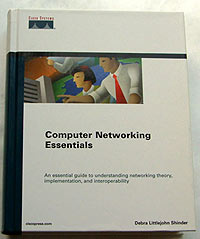Computer Networking Essentials: Book Review
 If you work in the IT field you probably spend much of your time fiddling around
with network settings, and occasionally reinstalling coworkers computers because
of evil programs like AOL instant messenger, ICQ or IM. Just like smoking, these
three programs seem to have the power to kill systems - don't ask me why I have
no idea. Anyhow, faced with the always pleasant reinstall of Windows because of
kamikaze messenger programs or because of the natural six month expiration of
Windows, those 45 minutes of waiting are the perfect time to read.
If you work in the IT field you probably spend much of your time fiddling around
with network settings, and occasionally reinstalling coworkers computers because
of evil programs like AOL instant messenger, ICQ or IM. Just like smoking, these
three programs seem to have the power to kill systems - don't ask me why I have
no idea. Anyhow, faced with the always pleasant reinstall of Windows because of
kamikaze messenger programs or because of the natural six month expiration of
Windows, those 45 minutes of waiting are the perfect time to read.
Now given the number of computers
I seem to be reinstalling around here, a book like Cisco Press's Computer
Networking Essentials which sits at a comfortable 735 pages, should be readable
in a week or so. Contained within the magical covers is everything you ever
needed to know about networks, and network settings. More of a handbook to the
IT department, or a text book for those dot.com executives who want to talk the
talk with their techies, Computer Networking Essentials explains in remarkably
understandable English the tools and technology that we deal with every
day.
Broken in to four main
sections that include Introduction to Networking Concepts, Networking Hardware
and Software, Network Specialty Areas and Future of Networking the book by Debra
Littlejohn Shinder is full of extremely useful information - even for us
so-called experts. Those of you studying for your MCSE take note, most of the
info in this book is useful for the Windows 2000 core exam.
From simple tasks like
configuring Windows 2000 on the network to getting your graphic artists' G4 on
the network with the rest of the PC's - yes it can be done so long as your
computers are running Win2K and have the proper services loaded for AppleTalk
communication apparently - Computer Networking Essentials covers it well. The
detail in the explanations differs from chapter to chapter and in most cases is
merly explanatory, but does point in a direction to head towards should you
need more detailed information on a question.
With security becoming a
serious concern for websites all over the internet, the section on Internet
security is of special interest. Covered are DOS attacks like ping flooding,
smurf attacks, ping of death, SYN attacks, and several other external and
internal methods of security breaches. Again, the book touches on each topic in
such a way as that the first time user, or novice will be able to understand. It
does not go into detailed explanations of the techniques or resolutions because
the books is more of a primer than anything else, but still chalked full of
useful info.
When the time comes and you
need to get more informed on networking - for work or for certification - a book
like Cisco's Computer Networking Essentials is a good place to start. It is not
geared towards experts in networking but designed more for those of us who have
patches of knowledge about networking techniques and technology. We found it to
be a very good introductory text and even helped us out with a couple of
explanations we were fuzzy on. By incorporating a broad range of topics that
deal not only with the theories used in everyday networking, but also
exploration into the hardware, software and implementation of these technologies
the book forms an essential tool in any IT departments toolkit. And as always,
it makes great reading material while waiting for Windows to install!
The
following chapters are included in
Cisco Press's Computer Networking Essentials;
Part 1 - Introduction to
Networking Concepts
- Introduction to PC
Networking
- Categorizing Networks
- Networking Concepts, Models
and Standards
- Networking Communications
Methods
- LAN Links
- WAN Links
Part 2 - Networking Hardware
and Software
- Physical Components of the
Network
- Networking Protocols and
Services
- The Widest Area Network:
The Global Internet
- Network Operating Systems
- Directory Services
- Desktop Operating Systems
- Hybrid Networks
Part 3 - Networking Specialty
Areas
- Protecting the Network
- Remote Access
- Virtual Private Networking
- Thin Client Networking
- Monitoring, Management and
Troubleshooting Tools
Part 4 - Future of
Networking

